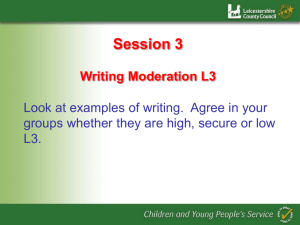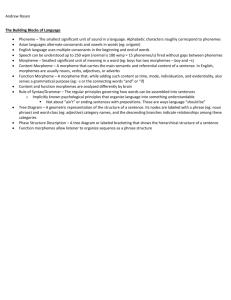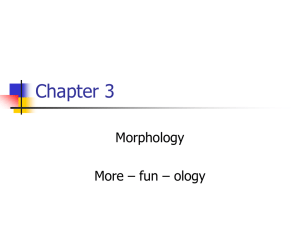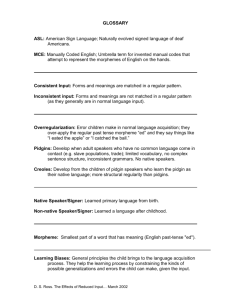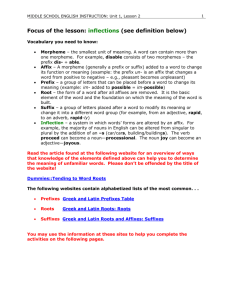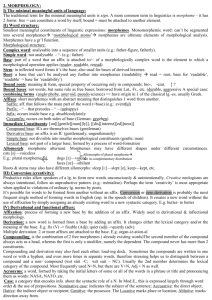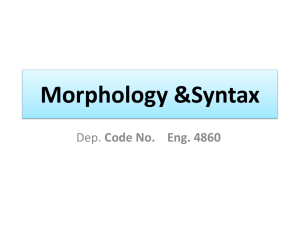How Words Are Formed
advertisement
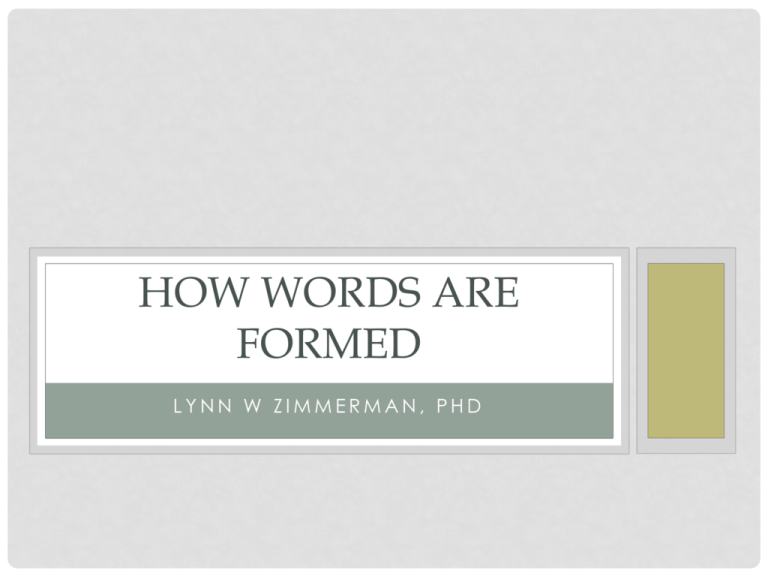
HOW WORDS ARE FORMED LYNN W ZIMMERMAN, PHD WHAT ARE WORDS? • Words - “sound sequences that are related to specific meanings” (p.5) • Words have space between them • Words are arbitrary –no inherent connection to the object they represent. • • • • Sound = form Concept = meaning Conventional = accepted meanings Sound symbolism = onomatopoeia KNOWING WORDS • When you know a word you know • • • • the meaning pronunciation orthography grammatical category or syntactic class it fits into MORPHEMES • The smallest unit of a word which has its own meaning. • one (monomorphemic) or more syllables • may be a word on its own • ball = 1 • balls = 2 – tree + s • football = 2 – foot + ball MEANING • The morpheme must have some meaning • -er • When used with a verb – means the doer of • When used with an adjective – means more • With father or water, the -er has no separate meaning - is not a morpheme FREE AND BOUND MORPHEMES • Free morphemes • words on their own • football = foot + ball • Bound morphemes • cannot stand on their own • unhappy = un + happy • happiness = happ[y] + ness AFFIXES • Root (base) - morpheme to which an affix is added – it may or may not be free • unhappy = un + happy • Stem (base) – root + affix – may or may not be a word on its own • Unhappiness = un + happ[y] + ness • Prefixes – before the root – related to meaning • unhappy = un + happy • Suffixes – after the root – related to part of speech • Unhappiness = un + happ[y] + ness • Infixes – morphemes inserted into other morphemes • Not very common in English GROUPING UNITS BY TYPES OF MORPHEME simple Complex compoun compoundd complex 1 free morpheme 1 free 2 free morpheme + morphemes 1 or more bound morphemes book green books greener 2 free morphemes + 1 or more bound morphemes bookcase bookcases greenhouse greenhouses GRAMMATICAL GROUPINGS • Nouns • Pronouns • Verbs • Adjectives • Adverbs • Prepositions • Conjunctions • Interjections There is scientific evidence that studying grammar does not improve reading and writing skills. Grammar acquisition through well-designed materials is more effective. CONTENT WORDS AND FUNCTION WORDS • Content words • Denote concepts – convey meaning • nouns, verbs, adjectives, adverbs • open class – new words are added regularly • Function words • no clear lexical meaning • provide grammatical connections among the content words • determiners, quantifiers, pronouns, auxiliaries, prepositions, conjunctions, particles, intensifiers, interjections • closed class – new words are almost never added • The brain puts more emphasis on content words. REFERENCES • Freeman, D. & Freeman, Y. (2014). Essential linguistics. Portsmouth, NH: Heinemann. • Fromkin, V., Rodman, R., and Hyams, N. (2007). An introduction to language. 8th ed. Boston: Thomson Wadsworth.


